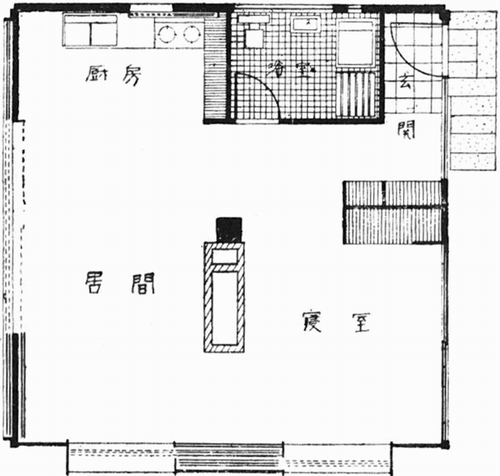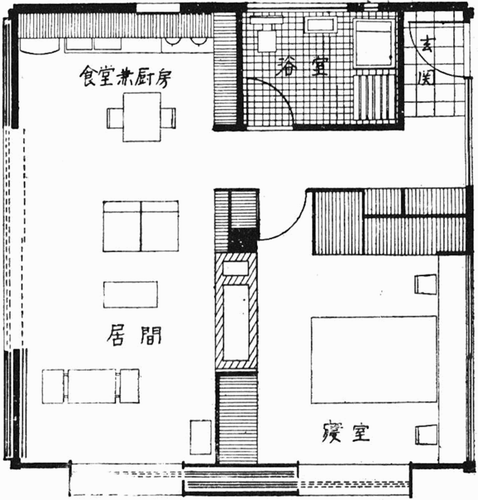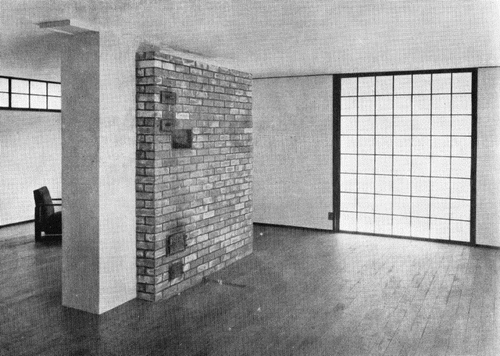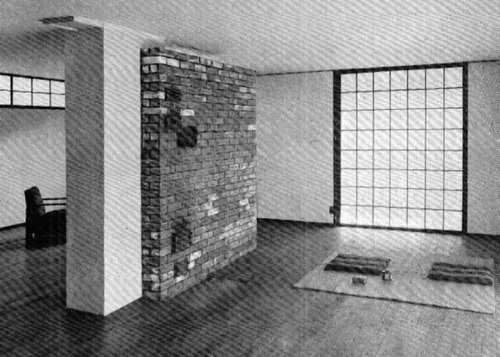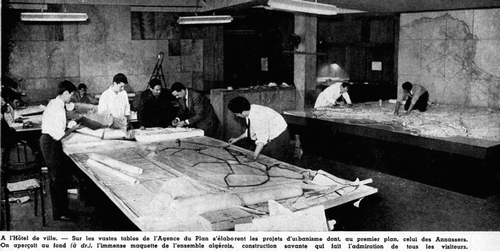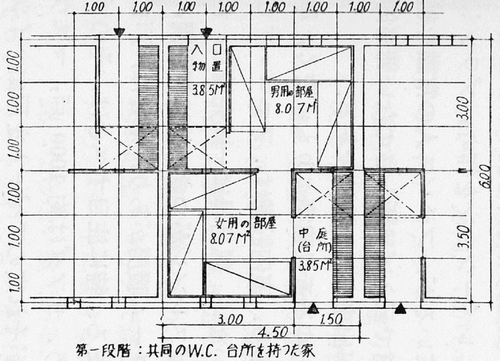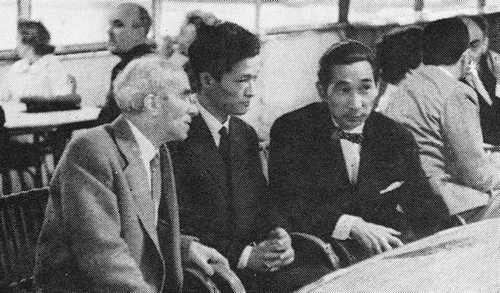Abstract
Gyoji Banshoya (1930–1998) was a Japanese urban planner whose life-work was urban planning in the Middle East and North Africa. The purpose of this paper is to provide an overview of his work, which still remains unknown. His early masterpiece, the ‘Square House’, shows how he was influenced by Kiyoshi Seike to apply historic spatial composition to realize width and convertibility in low-cost housing. Following this, Banshoya studied under the supervision of Gerald Hanning and George Candilis at Ateliers de Bâtisseurs in Paris, and went to Algiers to engage in the study of ‘evolutionary habitat’. As a United Nations Development Programme (UNDP) expert, he began working with Michel Ecochard in 1962 in Beirut, Damascus, and Aleppo. They were responsible for the elaboration of master plans for these three cities, and that of Damascus still remains as a legally active master plan today. Coupled with the Syrian political struggle since the 1980s, there has been some reaction against their modernist policies. However, the case is made for a detailed examination of Banshoya's work, and re-evaluation of its legacy for the urban planning history of the Middle East and North Africa.
Introduction
Historic cities in the Middle East and North Africa are thousands of years old. Modern urban planning was introduced when most were still under European colonization. They offer the planning historian important instances of how modern urban planning has balanced conservation and modernization, an issue that has remained salient for these cities in the years since independence. The present paper focuses on the work of a Japanese planner in this area. Gyoji Banshoya (1930–1998), a student of the Japanese architect Kiyoshi Seike, rediscovered the importance of estimating spatial change through some French modernist colleagues and continued as a principal urban planner in this region for the rest of his life. For example, one of his projects, a master plan for Damascus elaborated in 1968 with Michel Ecochard,Footnote1 is still an active official master plan approved by the Damascus governorate. His master plan for the city of Aleppo also remained active until recently. However, little is known about Banshoya and his work. Eric Verdeil mentions his existence as a collaborator of Ecochard.Footnote2 Jennifer Casagrande quotes and analyses his detailed plans and texts based on discussions with Stefano Bianca.Footnote3 But for the most part, his life in Japan, France, the Middle East, and North Africa remains little more than a footnote.
In giving a descriptive overview of the work of Gyoji Banshoya, the paper may prompt fresh reflection on aspects of recent urban planning history in the Middle East and North Africa. As I mention later, the physical appearance of some of Banshoya's work has been the object of both praise and criticism. Based on his own public reports for UNESCO, the seasoned urban planner Stefano Bianca regretted the destruction of the old city of Aleppo by road construction, the planning of which he attributed to Banshoya.Footnote4 More detailed analysis and evaluation of each of his projects is needed in the future. However, Banshoya's career as a Japanese planner is quite rare in itself and cannot be separated from, for example, the history of French urban planning overseas. In other words, to overview his work is to seek a turning point in urban planning history from modernization to conservation. The method adopted in this paper is a biographical study which seeks to offer a concise summary of the projects he worked on throughout his life.
Banshoya's work is summarized in . The approach employed in all subsequent sections is first to explain the primary sources, then position the data historiographically. Most of the planning documents were obtained from ministries or municipalities. Some were obtained from the Institut français du Proche-Orient (IFPO) in Beirut and Damascus, the archive of the Institut français d'architecture (IFA), of the Centre de Ressources Documentaires Aménagement, Logement, Nature (CRDALN), and of the Bibliothèque nationale de France (BnF) in Paris. In addition, I have drawn upon the brief listing of projects in Banshoya's own CV and upon articles and testimonies from his relatives and colleagues. Quotations from original documents in Japanese and French are accompanied with translations.
Table 1. Summary of the work of Gyoji Banshoya.a
The laboratory of Kiyoshi Seike and the Maison de Plan Carré à Tokio (1930–1953)
Gyoji Banshoya was born in 1930 as the second son of Eiichi Banshoya, a professor of German literature at Rikkyo University. In 1953, he graduated from the Department of Architecture at the Tokyo Institute of Technology. His supervisor was Kiyoshi Seike who had been teaching since just after his demobilization in 1945. As an editorial member of the architectural journal Shin-Kenchiku, Seike communicated frequently with leading foreign architects such as Antonin Raymond and Walter Adolph Georg Gropius, and was familiar with international architectural currency. Classmates of Banshoya included later celebrated architects such as Kazuo Shinohara and Shoji Hayashi (). One of the principles of the Seike Laboratory was that members should train overseas and it was also recommended that they participate in the Ministry of Foreign Affairs, Overseas Technical Cooperation Agency (OTCA) and Japan External Trade Organization (JETRO) projects as opportunities to go abroad.Footnote5 Banshoya, nicknamed ‘Ban-chan’, was close to Seike and he later invited his professor to his office in Damascus on a number of occasions. He also became a great advocate for younger graduates of the laboratory, such as Nobuo Goto, to study abroad.
Figure 1. K. Shinohara, M. Yamada, K. Seike, G. Banshoya, and S. Miyasaka.Source: Hayashi, “Seike Kiyoshi to Gendai no Jukyo Design,” 6.
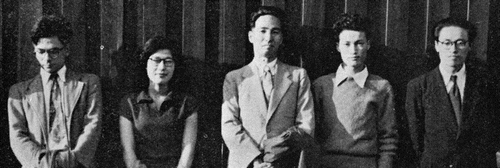
Just after graduation, Banshoya published his first architectural piece, ‘The Square House’ (Seihokei no Ie)Footnote6 in Shin-Kenchiku, which was the residence of his brother, Junichi, 6 years his senior. The point of the square plan of this house is its flexibility as a low-cost house; he used just one structural pillar called ‘Karagasa (paper umbrella) Structure’ accompanied by a Russian pechka stove to support the whole structure of the house and did not adopt any fixed partitions in order to make it possible for habitants to alter the living space themselves according to their family situation. This is why he showed both the simple ‘Surface Plan’ () and the ‘Completed Plan’ () which was to be completed by the habitants. According to Junichi, this concept was based on a traditional Japanese housing method called ‘Shinden-Dukuri'. The concept was that some furniture such as Byobu or Kicho was modified from its original purpose in order to be used for partition-free living. However, this concept was not born of nostalgia but of a reaction to the demand for designing small space, low-cost housing in the period after the war. This concept came originally from a design concept of Seike to realize, in a natural Japanese way, spatial variability corresponding to the changes from season to season.
The appearance of the house retained the traditional style. An anonymous reviewer of Shin-Kenchiku wrote: ‘The ambitious maiden work of a young architect just graduated from university … .Implying modernity in its classical elegance of appearance, the house shows the youthful motivation of the architect’. This means that the Square House was evaluated in the context of a balance between Japanese tradition and modernism.
The Square House was also published in the French architectural magazine l'Architecture d'Aujourd'hui in October 1953, titled ‘Maison de Plan Carré à Tokio’.Footnote7 The feature topic of this number was ‘Habitat’ and the results of critical discussions at the Congrès International d'Architecture Moderne (CIAM) IX conference were promptly reported by George Candilis, Vladimir Bodiansky, and Michel Ecochard. Banshoya's work was introduced just after Candilis's general remarks.Footnote8 In the article by Banshoya himself, he explained that Japanese habitations were in the process of a transformation from the traditional to the modern and suggested that he had abandoned the use of Tatami (Japanese traditional carpet sized 180 cm * 90 cm which is also used as a measurement of floor space), but retained it as a module of the house. In the version of l'Architecture d'Aujourd'hui, he showed a photo of a room with movable Tatami () which did not appear in the Shin Kenchiku version (). On the other hand, Candilis referred to the Square House in his remarks and evaluated it as a kind of ‘habitat evolutif (evolutionary habitat)’, showing his own sketch () and writing ‘The architect only designs the frame of the house and fixes and constructs the installations (sanitary block). The rest of the house should be completed by the habitants themselves according to their needs and their habits’.Footnote9 Here we see the basic concept of evolutionary habitat manifested by Candilis and other modernist architects in Casablanca in order to supply low-cost housing called Habitation à Loyer Modéré (HLM) to the general public. Based on his experiences in Morocco and other developing countries, Candilis was trying to overcome the rigidity of CIAM discipline. For Candilis, the Square House should definitely have been positively evaluated because it showed a case of evolutionary habitat in Japan, something that was in urgent demand in architecture after the Second World War.
Figure 6. Candillis's dessin of the Square House in l'Architecture d'Aujourd'hui ‘evolving’ from Left to Right. Source: Candilis, “L'habitation Individuelle Minimum,” 1.

Besides planning the Square House, Banshoya was diligently following European trends in collective housing. His research resulted in the translation of an article from l'Architecture d'Aujourd'hui, published in Shin-Kenchiku in September 1953. The translated article was titled ‘Residential District Planning in Postwar Italy’.Footnote10 It was not just a simple translation but an editorial translation; the thoughts of translator himself were reflected in the composition of the article. For example, Banshoya intentionally selected two articles (from Giuseppe Samonà and Saverio Muratoni) to be translated. He chose the future pioneers of Italian urban conservation who belonged to the National Institute for Assurance of Housing (INA Casa) which was providing low-cost houses in postwar Italy.
It is clear that much was expected of Banshoya as an architect of ‘evolutionary habitat’ in his younger days. His concept was not simple revivalism or a kind of nostalgia but a reconstitution of historical spatial composition based on the necessity of modern elements, and a recognition that physical spaces are bound to change as time goes by. As a matter of fact, the Square House carved out his career dynamically. The work was finally evaluated by Le Corbusier in his capacity as a juror for French governmental scholarships.Footnote11 Six months after graduation, Banshoya was given the chance to study in France as a French government traineeship.
ATBAT and Agence du Plan in Algiers (1953–1958)
ATBAT and Agence du Plan
In October 1953, Banshoya started work as a scholar-trainee of the French government (boursier du gouvernement français) at Ateliers de Bâtisseurs (ATBAT). His name is listed in a monograph about ATBAT by Tournon-Branly Marion.Footnote12 ATBAT was an architectural office founded by Le Corbusier and some of its young architects were Bodiansky, Candilis, and Hanning, who were well known for their activities based in Casablanca.Footnote13 Gerald Hanning was the managing director of Le Corbusier's office and Candilis was a leading architect at CIAM in its later days. According to his CV, Banshoya was dispatched to the Paris office of ATBAT and worked on researching case studies in Madagascar and Paris concerning ‘Habitat for the Greatest Number (Habitat pour le Plus Grand Nombre)’ under the supervision of Bodiansky, Candilis, and Hanning.Footnote14 ‘Habitat for the Greatest Number’ was a movement to provide low-cost houses to resolve slum issues inspired by Ecochard who advocated ‘Urbanism for the Greatest Number (Urbanisme pour le Plus Grand Nombre)’ in Morocco. ATBAT was a major participant in this movement. Under the name of ATBAT, Banshoya participated in research about ‘evolutionary habitat’ and the results were published as an article.Footnote15 As Tom Avermaete points out, ‘habitat’ was a notion which means culturally adapted habitat (habitat adapté) based on dwelling practice in climatological, geographical, and geological characteristics in the area.Footnote16 Unlike Takamasa Yoshizaka, who went to Paris in 1950 to study under Le Corbusier for two years, Banshoya, who studied under the new generation of CIAM, was destined to learn about the cities of the Middle East and North Africa.
In July 1954, Hanning was invited by the mayor of the city of Algiers, and his disciple and colleague Banshoya also followed him across the sea. The mayor, Jacques Chevallier, had just founded a special institution called Agence du Plan (Planning Agency) in June 1954. It was a consultative body under the direct control of Mayor Chevallier who intended to make Algiers into a Ville d'Example (model city) or a Ville Pilote (pilot city) of North Africa where indigenous Muslim Algerians and French Christian colonials could cohabit.Footnote17 It was Pierre Dalloz who advised the mayor to found the Planning Agency following the example of the office for the reconstruction of the city centre of Le Havre established by Auguste Perret. He was installed as the director of the Agency and Hanning was named as his manager. Under Hanning, there were some Chef-Adjoints (assistant managers), including Banshoya.
Political/cultural background of Algiers
Algeria had been a French colony since 1830 and the city had experienced many manifestations of modern urban planning. The array of French apartment-style facades in the coastal area at Algiers port already existed in the 1840s. In the 1930s, René Danger, Henri Prost, and Le Corbusier made proposals and their plans were partially realized. From 1953, a French architect, Fernand Pouillon, began work on the three famous collective housing projects called Grands Ensembles, Diar es-Saada, Diar el-Mahcol, and Climat de France.Footnote18 Banshoya lived himself in a Diar el-Mahcol apartment where he communed with the aesthetics of Algiers's colours and forms in everyday life.
However, the period during which Banshoya stayed in Algiers was quite a critical phase politically. Just after his arrival, the Front de Libération Nationale (FLN) launched their anti-France movement in November 1954. The battle of Algiers, famous for terrorist acts as described in Gillo Pontecorvo's movie, started in 1957. After years of struggle, Mayor Chevallier was forced to resign in May 1958 then the Quatrième République collapsed in October 1958. Algeria finally got independence in 1962.
Under such circumstances, Chevallier's administrative policy was to improve people's living environment by providing as much low-cost houses as possible. In particular, it was quite important to balance housing policy between Muslims and Christians. In reality, it was meant to provide more houses for Muslims and it was certainly fair in view of the population ratio. Under Mayor Chevallier, many HLM projects aimed at the Muslim population were planned and implemented.
Evolutionary habitat and street planning through teamwork
According to the CV of Banshoya, the projects he participated in were as follows:
Plan d'Aménagement au 1/2,000ème de la réorganisation du centre-ville d'Alger (surface approximative: 30 ha)
Plan d'Aménagement, études du plan de masse et mise au point d'infrastructures (du 1/5,000ème au 1/500ème) de la nouvelle ville des Annassers (100,000 habitants – 700 ha)
Plan d'aménagement du quartier du Champ de Manœuvres à Alger (1/500ème – 1/200ème – 1,500habitants)
Plan d'Aménagement et recasement du « bidonville » de Mahiedine (1/500ème – 5,000 habitants).
Plan d'Aménagement de Chateauneuf à Alger (1/500ème – 3,000 habitants)
Plan d'aménagement et plan de masse du quartier de Frais-Vallon (1,500 habitants).
Plusieurs études sur l'habitat pour le recasement de ‘Bidonville’
Plan Directeur de la région d'Alger (1 million d'habitants (1/5,000ème et 1/2,000ème)
Figure 7. G. Banshoya introduced in Alger Revue.Source: Dalloz, “Le bureau du plan de la ville d'Alger,” 1–9.
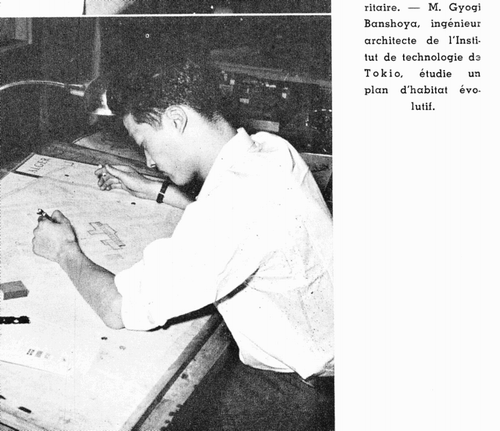
Here I will briefly explain Banshoya's work comparing his CV and articles from the Alger-Revue. Project No. 2, collective housing at Annassers, was most frequently written about. The first article about Annassers was published in 1956 to report on the project,Footnote20 and then a second article was published in 1959 reporting that Banshoya was working on a maquette of the project site ().Footnote21 In 1961, some photos were published showing a partial realization of Annassers. Footnote22 Project No. 3 was a renovation of the huge, modern apartment designed by Bernard Zehrfus in 1952 in order to reorganize it from a Corbusier-type space to a more sophisticated space. Project No. 4 was to provide HLM housing to about 8000 city centre squatters. Its completion was reported in 1959.Footnote23
Temporary habitat replacing tin-roofed shelters
A concrete result of Banshoya's achievements in Algiers is Project No. 7, ‘Several Studies on Habitats for Readjustment of “Slums”’, which was led by Banshoya himself and reported in the Japanese architectural magazine Kenchiku Kai in December 1955. It was an article which Banshoya himself titled ‘Apartments in Algeria’, with the main theme of housing problems stemming from the migration of people from rural areas into the cities, and his proposal for its solution was called ‘Temporary Habitat Replacing Tin-Roofed Shelters’.Footnote24 It was a sort of slum project called Cité de Recasement which was being built widely in Algeria at that time. Cité de Recasement was temporary habitat for slum residents waiting for an official HLM to be completed. However, a characteristic of Banshoya's project was his concept respecting Arab customs. In the text attached to the plans, he suggests that three rules based on Muslim customs should be respected: (a) the interior cannot be seen from the exterior, (b) a patio is necessary, and (c) men mainly live outside of the house, and women mainly live inside the house or outside in areas for women only. Women never show their faces outside of the house except in the presence of their husbands.
The block plan shows a collective housing project composed of 10 units (). Each unit has 16 or 17 houses surrounding a patio for the unit. In other words, all patios are positioned in the centre of each unit. What is important is that the plan of the house was also composed of two steps. The floor plan (first step) shows that each house has two rooms, and the entrance is defined as the patio of the house (). For the first step, the water closet (WC) and the dining area are located in the patio of the unit and are shared by all the residents of the unit. Then for the second step, the shower, WC, and dining area are installed in the patios of each house so that there is more privacy (). Here, the concept of ‘evolutionary habitat’ meant a step-by-step development process to realize living conditions based on Muslim customs. This design principle can be recognized as a kind of reconstitution of historic spatial composition because of its intention to adapt to the housing traditions of Muslim Algerians.
Figure 9. Block plan of ‘Temporary housing replacing tin-roofed shelters’.Source: Banshoya, “Algeria no Apart,” 2–7.
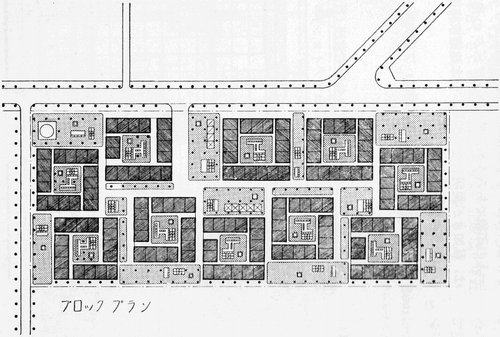
Figure 11. Second step with a patio equipped with a Kitchen and a WC.Source: Banshoya, “Algeria no Apart,” 2–7.
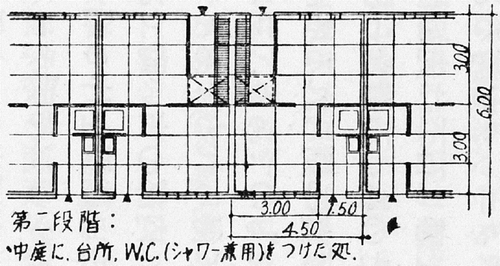
Here we may require some discussion about Banshoya's design policy. The block plan apparently looks like Tram Ecochard in Morocco, but actually this kind of simple reproduction of a typical patio house was not the mainstream in Algeria. As Çelik showed, the houses of Grands Ensembles and many other collective housing projects by, for example, Roland Simounet, used to have a space called ‘patio’ but it was not a typical patio situated in the centre of house. Rather, it was installed in front of the exterior and sometimes called a ‘lodge’. Compared to this mainstream of innovative houses, Banshoya's design seemed stubborn in its quest to realize ‘habitat for Muslims’.
This point reminds us that the idea of ‘the Islamic city’ showing specific spatial composition for Muslims was harshly criticized by Abu-Lughod 30 years later:
They have been influenced, whether wittingly or not, by a body of literature produced by Western Orientalists purporting to describe the essence of the Islamic city. … Can we nurture neighborhoods that are supportive but not defensive? Can we foster privacy not for women alone but for households? Can we guard the rights of neighbors while still applying laws consistently? That is the task Arab city planners must set for themselves.Footnote25
In her view, the mainstream of innovative houses in Algeria is, of course, positively evaluated. But how is it for Banshoya's work? What is most important in this paper is the fact that Banshoya was examining the possibility of spatial variability based on history. However, if we carefully examine the plans of Banshoya, the existence of entrances opening directly onto the exterior or the patio, which were not completely closed, seems to imply some new kind of spatial composition shared by that proposed by Abu-Lughod.Footnote26
Towards urban planning
Banshoya's colleague, Jean-Jacques Deluz (later an architectural historian), introduced him as the third architect of the Agency, and stated that Banshoya was engaged in the planning of streets and intersections due to the fact that he was ‘a genius of design as well as of Japanese calligraphy’.Footnote27 Deluz had joined the Agency in 1957 and became its director in 1959. We can deduce from the timing that his description must be of Banshoya's latter days in Algiers, when he was working on No. 2 Annassers. This project involved a district plan including street layout, extending his work from residential to urban scale at Gerald Hanning's behest.Footnote28
In 1958, Mayor Chevallier received the ‘Grand Prix d'Architecture’ from the Cercle d'Etudes Architecturales. In his acknowledgement of the Grand Prix, Chevallier demonstrated his appreciation of the members of the Agency saying he owed all his success to them. He listed ‘Japanese’ at the top of his list of international members at the Agency.Footnote29
M. Pierre Dalloz est venu nous aider dans cette tâche en groupant autour de lui un certain nombre de jeunes hommes et de jeunes femmes, français et étrangères (des Japonais, des Américains, des Polonais, des Péruviens) qui tous ensemble, travaillant en équipe, permettent de faire une synthèse de nos problèmes et de répondre à tout.Footnote30
[English Translation] Mr. Pierre Dalloz came to help us for this task by grouping around him a number of young men and young women, French and foreigners (Japanese, Americans, Poles, Peruvians) who together, working as a team, allow to synthesize our problems and to respond to everything.
There is no doubt that this ‘Japonais’ refers to Banshoya who contributed to the Agency to make Chevallier's teamwork so successful. Because work for the Planning Agency was usually carried out in team projects, most of Banshoya's works were not credited to him individually. However, it should be noted that Banshoya played a role at the Planning Agency as a planner of evolutionary habitat, and as a genius of design for street planning as well.
Encounter with two maestros and assignment as a United Nations Development Programme (UNDP) specialist
The two maestros
In May 1958, Chevallier resigned after his efforts to maintain peace and the Agency was also downsized. Banshoya decided to go back to France where he established his own small office beside the Place de Vosges in Paris.Footnote31 With Paul Herbe, a friend since his time in Algiers, he collaborated with architect Max Richter on a project for an international architectural competition for a new post office in Berne, Switzerland. The plan was not realized, but it was published in l'Architecture d'Aujourd'hui in February 1959 ().Footnote32 From March of that year, he went back and forth to Algeria to participate in the elaboration of a new district plan for Bone, which dates back to the Roman ruin of Hippone. Footnote33 He collaborated with two French architects, Roux Dorlut and Daniel Badani. This project continued until February 1961 but he did the work on this project from his office in the Place de Vosges.
Figure 12. Post office in Berne published in l'Architecture d'Aujourd'hui.Source: Richter and Banshoya, “Direction Cantonale des Postes,” XXXVII.
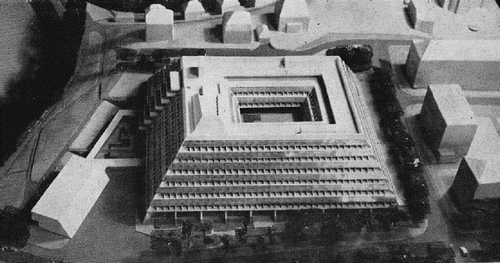
In June 1959, Banshoya met two grand maestros. The first was Kenzo Tange, who came to France to receive the first international architectural prize from l'Architecture d'Aujourd'hui. Banshoya played the role of interpreter for Tange ().Footnote34 After that, he became a collaborator in some of Tange's projects in the Middle East and North Africa. The second maestro was Michel Ecochard whom he met at the party held for Tange on a bateau-mouche (pleasure boat) on the Seine. Through his acquaintance with Ecochard, who had experience of working with some members of CIAM and ATBAT for ‘Urbanisme for the Greatest Number’, Banshoya became more interested in the Middle East and North Africa.Footnote35
Banshoya first participated in projects in the Middle East in February 1961 when he was 31 years old. Prior to this, he had participated in a resort project of Ecochard in Corsica that also involved Kunio Kato, later a professor at the University of Kyoto. Ecochard, who had been impressed by Banshoya during their first encounter, invited him to Beirut and their families formed a close friendship. As a valuable assistant to Ecochard, Banshoya participated in some district plans for Beirut such as the ministries quarter, the Medawar quarter, and the small resort city of Jounieh.
Assignment as a UNDP specialist in Cambodia
In January 1962, Banshoya was appointed as a UNDP technical assistance officer and was sent to the Direction of Urban Planning of the Ministry of Public Enterprise and Information in the Kingdom of Cambodia.Footnote36 Just after independence from French Indochina in 1954, Cambodia asked the United Nations to cooperate in the reconstruction of their new capital. His main counterpart was Vann Molyvann who graduated from the École des Beaux Arts in Paris, burning with enthusiasm for rehabilitation of his country through a modern revival of traditional Khmer architecture.Footnote37 The person who invited Banshoya was his ex-supervisor Gerald Hanning, the leader of UNDP specialist. Banshoya's mission was only for one year and he worked as a member of a team led by ATBAT members just as he had in Algiers. In addition, Banshoya met a young Japanese man, Nobuo Goto, who would become his most trusted collaborator in Damascus at a later date.
According to the CV of Banshoya written in French, the projects in which he participated were as follows:
Stade olympique (70,000 personnes), piscine, gymnase (8,000 personnes), de Seop Games à Phnom-Penh.
Plan d'aménagement de détails de la ville de Phnom-Penh (400,000 habitants)
Plan de masse au1/500ème de Front de Bassac à Phnom-Penh (5,000 habitants)
Plan d'exécution des nouveaux quartiers de Sihanoukville
Réseau routier de Sihanoukville
Surrounded by the Cardamom Mountains, Sihanoukville was a new city planned as the first deep-sea port in Cambodia. Project No. 4 was also a district plan for the seacoast elaborated in 1962 based on the city's first master plan elaborated in 1959 thanks to Bureau central d’études pour les équipements d'outre-mer (BCEOM) and United States Operations Mission (USOM). The plan includes rationally planned modern collective houses and facilities for leisure and tourism. Project No. 5 appears to be some kind of complemental work to finish National Road 4 connecting Sihanoukville with Phnom-Penh.
As Banshoya moved to Beirut, Goto took over his work, but in his own way. Goto and his colleague Setsuo Okada carried out throughout a design survey of raised-floor-style houses which are quite popular in villages of the area. A Khmer house is small and simple, but it is obvious that a great deal of traditional wisdom accumulated by the residents is adopted here – for example, the use of natural and low-cost building materials, good ventilation in the house thanks to the openings, and safety assured by the raised-floor. He worked for a housing project entitled Habitat Experimental (Experimental Habitat) under the supervision of Hanning. This project was published in L'Architecture d'Aujourd'hui, explaining their concepts.Footnote40 The concept of their experimental habitat was to provide functional and low-cost houses that inherited the many merits of traditional Khmer houses in modern form. The method of construction was ‘Autoconstruction’, meaning self-build by amateurs, especially the residents themselves. Under the supervision of the Service of Urban Planning and Housing, they realized a prototype of their experimental habitat in 1962 in a city area of Phnom-Penh (). Molyvann regarded it as one of his favourite experiments in what he called ‘Modern Khmer Architecture’.Footnote41
Figure 14. Plan of the prototype. 1. Living Room, 2. Sleeping Room, 3. Kitchen, 4. Storage, 5. Watering PlaceSource: Hanning, Goto, and Okada, “Réadapter l'Autoconstruction Tentative Cambodgienne (1963),” 20–22.
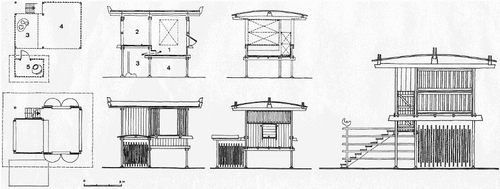
However, the implementation of other projects was cancelled due to the civil war. Sihanoukville was later developed to be the second city of Cambodia under a new master plan in the 1990s.Footnote42 Though Banshoya's mission in Cambodia was limited to one year, it was significant as his first assignment as a UNDP specialist. He would continue to be a UNDP specialist until the 1970s, when he elaborated the master plan of Aleppo. His partner Goto was also an architect who respected history. At this point in time at least, Banshoya and Goto, who would become the main collaborators of Ecochard for the master plan of Damascus in 1968, cherished history and regional culture.
Master plans for three cities in the Middle East
Michel Ecochard was the most influential urban planner for the elaboration of diverse plans, such as public facilities or district planning, in Lebanon under President Fouad Chehab, who was promoting the modernization of the country. Banshoya was re-called to Lebanon by Ecochard at the end of 1962 and after that he would be engaged in missions in the Middle East for the rest of his life. In particular, master plans for the three cities of Beirut, Damascus, and Aleppo are considered as his principal works.
Beirut (1962–1966)
The ancient city centre of Beirut had suffered damage in the First World War, compounded by clearances under the last Ottoman governor Djémal Pasha. In the era of the French Mandate, a postwar reconstruction project based on Baroque-style design was devised by French urban planner René Danger, with a central square and main streets in a radial pattern.Footnote43 With its down town playing the role of the financial centre of the Middle East, Beirut became known as the ‘Paris of the Middle East’. In 1943, Ecochard proposed an unsuccessful plan of road improvements. Following his ‘Urbanism for the Greatest Number’ mission in Morocco, he tried again, elaborating the first master plan of Beirut after independence in 1963.Footnote44 According to the master plan, the chief planner was Ecochard, and Banshoya was listed as one of the four assistants. Another document provided later by the French Institute of Architecture regards Banshoya as Ecochard's first assistant and states that Ecochard and Banshoya were coordinators for young Lebanese architects in charge of district planning. The two coordinators were mainly engaged in traffic planning and the creation of public spaces.Footnote45 As a result, they elaborated a city centre district plan indicating reconstruction of the two quarters adjoining the downtown Ghalghoul quarter and the east quarter of the place of Martyrs in 1964 ().Footnote46 The subject of this district plan was to activate the city centre without destroying the downtown quarter.
Figure 15. Maquette of the 1964 District Plan showing the redevelopment plan for Ghalghoul and the quartier Est de la Place de Place de Martyrs.Source: Photograph by G. Banshoya.

Banshoya's other Lebanese projects included work on the 150 km Autoroute de Zaharani, connecting Saida and Tripoli, which became the most important artery of the country, and a plan for the residential district of Naameh (40,000 habitants).Footnote47 Amid the disruptions of the civil war of 1975–1990, he continued to work in Beirut. His practice also served as a Middle East branch of Kenzo Tange's office.Footnote48
Damascus (1966–1968)
Damascus is one of the most ancient cities in the Middle East, with 5000 years of history, more than 100 monuments, and an urban form that combines grid pattern Roman streets and crowded narrow lanes of the Islamic age.Footnote49 In 1936, when Syria was under the French Mandate, Danger and Ecochard prepared its first master plan. At that time, Ecochard was in charge of archeological survey in Damascus, supporting Danger, and the main policy object was to create a new city outside the old. Two decades later, in reaction against proposals for a gyratory around the Umayyad mosque, the third oldest in the world, UNESCO asked Ecochard back to make a new plan for the city.Footnote50 He appointed Banshoya as his first collaborator and the master plan of Damascus in 1968 was credited to their two names.Footnote51
In February 1966, Banshoya became a professor at the Faculté des Beaux-Arts de l'Université de Damas (Faculty of Art at the University of Damascus) which had been just founded. The following August he was contracted as a UNDP technical assistance officer for Syria, with responsibility for a wide range of projects including detailed planning on Damascus, the master plan for Aleppo, three village plans, and the development of research centre and teaching for architecture and planning.Footnote52 The main Syrian counterparts on the Damascus project were Mamdouh el Zerikly, director of the municipality and Alexis Chakar, director of the Urban Planning Service of the Ministry of Rural and Municipal Affairs, who graduated from the University of Washington.Footnote53 In addition, the name of Goto was listed as a collaborator in the plan. Planned population was set to one and half million which was twice that of the population in 1936 and the city was to be expanded with detailed zonings such as industry, housing, and conservation areas. Traffic planning was also emphasized in Damascus in order to cope with the era of cars. In fact, a highway connecting with other Syrian cities was proposed to introduce some roads inside the old city.
From this point of view, what is interesting about this master plan is the detailed plan of the old city. So far, Banshoya's contribution has appeared to be his role as assistant to Ecochard. However, there are at least two sources which support the idea that Banshoya was the leader, at least for the detailed plan of the old city. First, quoting the text of the master plan of 1968, Mohamed-Amer Kallaa attributes the concept of the detailed plan in 1:500 to Banshoya in his doctoral thesis.Footnote54 He shows no evidence of Banshoya's role in the detailed plan, but according to Paul Chiniara who was working for the Urban Planning Service of the Damascus governorate from 1966, Banshoya tried to rediscover the Roman grid streets in order to renovate them as roads.Footnote55 In fact, the master plan included a study map of the old city entitled ‘Reconstitution de la Ville Antique (Reconstitution of the Antique City)’ ().
Figure 16. Study Plan ‘Reconstitution de la Ville Antique’ in the Master Plan of 1968.Source: Ecochard, and Banshoya et al., Plan Directeur pour l'Aménagement de la ville de Damas et sa Région.
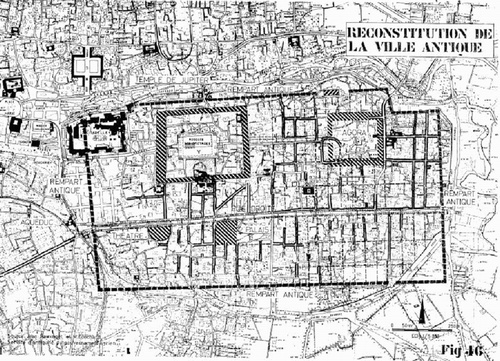
Banshoya believed that this idea was still based on the reconstitution of historic spatial composition. After five years of elaboration, Ecochard and Banshoya spoke of their thoughts concerning planning in l'Architecture d'Aujourd'hui in September 1973:
Que faire? Doit-on abandonner ce centre commercial et en reconstruire un dans la zone d'extension moderne de la ville? Cette solution permettrait de dégager les 21 caravansérails et de les transformer en musées. La chose est impossible … Doit on conserver ce centre dans son état et son fonctionnement actuel? Non, les caravanes se sont muées en camions de 20 tonnes qui obstruent totalement les petites voies et rendent chaque jour plus impossible la circulation mécanique et piétonnière.Footnote56
[English Translation] What to do? Should we abandon this commercial centre and rebuild one in the modern extension area of the city? This solution would release 21 caravanserais and turn them into museums. Such thing is impossible … Must we conserve this centre in its current state and function? No, the caravans have developed into 20-tonne trucks that completely obstruct small lanes and make mechanical and pedestrian traffic more impossible each day.
No doubt Ecochard and Banshoya proposed their plan with a deep understanding of the conflicts and complications of urban conservation, and the risks of merely ‘freezing’ historic tissue. However, their master plan would be strongly criticized later. Various revisions have been made including one prohibiting development in the old city in 1984, but the regulatory framework such as zoning is still active. Amid the confusion of the Syrian civil war, the plan remains in force in 2015.
After the work in Damascus, Goto was assigned to the Paris office of Ecochard and left Damascus, but the Syrian–Japanese link continued. The first Japanese specialists from the OTCA (later JICA, Japanese International Cooperation Agency) were Masao Okui and Yukio Cho from the Seike Laboratory. They were in charge of some district plans as smaller, more detailed parts that supported the master plan. The first urban district planning project based on Japanese cooperation was introduced in Okui's final report in 1973.Footnote57 They and their Syrian counterparts worked in the office called ‘Maktab (Office) Banshoya’ on the rooftop of the Damascus governorate. Cho's activity was broadcast by TBS in 1974. That was the first example of Japanese cooperation in Syria, as well as the contribution of the legendary Japanese veterinarian, Giro Orita. Besides their cooperation with the government, Kenzo Tange and his team The Urbanists and Architects Team (URTEC) realized the New Presidential Palace and Tishurin Park in Damascus in the 1970s.Footnote58 Since 2008, there have been new attempts to revise the master plan in cooperation with a JICA team led by the planner Tsuyoshi Hashimoto.Footnote59
Aleppo (1969–1975)
Aleppo is another of the most important historic cities in the Middle East. The main characteristic of this city is its solemn townscape of stone buildings. The city was also famous for its traditional Souk (market) which used to be a huge commercial centre on the Silk Road. In 1954, French urban planner André Gutton, a professor at the École des Beaux Arts in Paris, elaborated a radical master plan which included some road construction inside the old city.Footnote60
Banshoya's work in Aleppo became the most important projects of his life. According to the contract between UNDP and Banshoya, his most important Syrian counterpart at this time was Chakar, who was now general director of the Ministry. In the municipality of Aleppo, there was a young French scholar, Jean-Claude David (later an architectural historian), who lived there from 1968 to 1972. With his extensive knowledge about the urban fabric of Aleppo, David became an important collaborator for Banshoya. In addition, an important Syrian partner worked in the municipality, whom Banshoya married later after her resignation. Banshoya often needed her signature as well as her help to finish his plans. This mission of UNDP was renewed in 1970 for another three years (1970–1972), then for a further three years (1973–1975) after that.
In April 1970, Banshoya had already finished the first study report and he published his ideas in l'Architecture d'Aujourd'hui in September 1973 jointly with David. Here, they also emphasized the importance of connecting the old city with the other parts of the expanded city. They argued that the traditional spatial order of the old city was now being lost as a result of abandonment and they presented their concept to activate the old city by introducing some lanes without cutting through the old city, showing some diagrams ().Footnote61 In fact, they deleted most of the preceding road plans proposed by André Gutton which were cutting through the Souk. Their basic idea was to introduce some small parking lots behind Khans, the caravansaries which used to be bases for commercial activities in the Souk. The parking lots were limited to mini-trucks as an alternative for caravans, which were rapidly becoming out of date, and the roads for mini-trucks were designed to avoid the historical area (). It should be clear that Banshoya tried here to manage both conservation and activation of the old urban fabric at the same time. His principle of reconstitution of historical spatial composition based on the necessity of modern elements was still alive.
Figure 17. Diagrams of the old city.Source: Banshoya and David, “Projet d'aménagement de la vieille ville d'Alep,” 84–85.
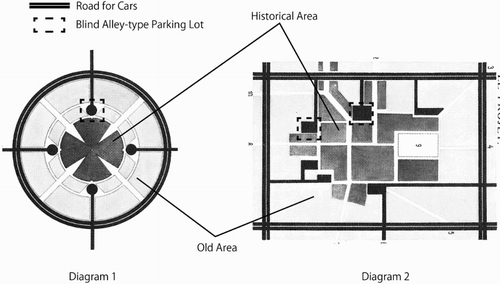
Figure 18. Proposed Detailed Plan for the old city.Source: Banshoya and David, “Projet d'aménagement de la vieille ville d'Alep,” 84–85.
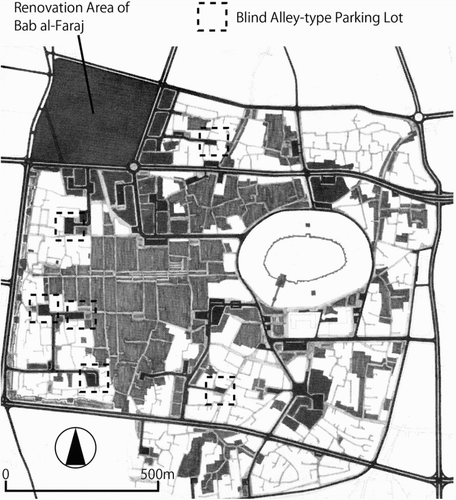
Thus, Banshoya finally became the chief urban planner in Aleppo, seconded by Henrick Roral, an architect from Poland. The master plan was officially settled in 1975 and they were credited with their names in Arabic.Footnote62 Banshoya was also responsible for the urban renewal project in the historic quarter of Bab al-Faraj. Its maquette was published in the Lebanese magazine l'Orient-Le jour Samedi in January 1975 so at first it seemed to have been accepted in general. However, the project was destined to be cancelled because of the criticism I mention later.
On the whole, Banshoya, in his best days, was playing quite an important role as a leading urban planner in these three cities in the Middle East. While based in Syria he also elaborated master plans for the Iranian cities of Rasht and the Ville de Pahlevi (later Bandar-e Anzali) with Ali Sardar Afghami, a former disciple of Ecochard.Footnote63 From the viewpoint both of scale and methodology, Banshoya's work compares with that of famous French planners such as Danger, Ecochard, and Gutton.
Ecochard and Banshoya's philosophy of conservation and modernization
After the expiration of his contract with UNDP in 1975, Banshoya based himself in Beirut. He joined the Dar al-Handasa company within its Directorate of Urban Planning and participated in the reconstruction of Beirut. In 1977, he became a professor at the Lebanese Catholic University. He also taught at St. Joseph's University and other Lebanese universities.Footnote64 No longer undertaking large-scale master planning exercises, one of his final projects was the Japanese ambassador's residence in Beirut.
In 1977, Banshoya, at 47 years of age, published an article in Kenchiku Zasshi (Journal of Architecture and Building Science) of the Architectural Institute of Japan. The article was titled ‘Urban Formation in Syria’ and it described how Syrian cities formed their multilayered urban tissue containing all the civilizational elements of Syrian history starting from the Euphrates civilization, via Hellenism and Roman civilization to Islamic civilization.Footnote65 The theme is historically magnificent, but in the last pages the author referred to the actual implementation of modern urban planning. He mentioned that Ecochard widely contributed to the institutionalization of the conservation of historic monuments in Syria while trying to limit the chaotic expansion of the city by introducing detailed architectural laws. Of the project with which he concerned himself, he wrote that conservation plans for the old cities were finally approved in spite of various arguments. In addition, he affirmed that the number of young Syrian specialists was rapidly growing due to international cooperation. In his acknowledgements, he noted the names of Seike and Iwao Kobori (Professor at the University of Tokyo, Geography).
France carried out many urban planning projects in its colonies, protectorates, and mandatory territories, and Ecochard was one of the most influential practitioners. His modernist legacies have not always been evaluated in a positive sense. In particular, his method of introducing roads inside old cities has sometimes been criticized for its negative influence on the historic fabric.Footnote66 Banshoya worked in a similar manner to Ecochard and his plans were similarly criticized by the emergent movement for conservation of historic areas. Opinion shifted radically in the later 1970s. In 1976, the Department of Antiquity of the Syrian Ministry of Culture – the institutionalization of which Ecochard himself had contributed to in the past – introduced directives to enhance the law concerning the conservation of ruins and historic monuments.Footnote67 An early example of grassroots movements for conservation was the establishment in 1978 of the Aleppo Old City Committee. With the encouragement of the committee, the Department of Antiquity registered the whole old city as a historic monument and UNESCO launched a survey project on urban conservation in 1979. The project leader was the famous Swiss architect, Stefano Bianca, who had a wealth of experience in conservation planning, for example, in Fez, Morocco and Cairo, Egypt. The UNESCO report titled ‘The Conservation of the Old City of Aleppo’ in 1980 pointed out that though it is much better than Gutton's plan, Banshoya's plan of 1975 lacked recognition of the differences between the old city and the new city and concluded that the master plan should be promptly revised.Footnote68 When Nadj Otori, who was originally from an old family of the old city and who went on to become an architect, became the mayor of Aleppo, he adopted the principles of the UNESCO report and started to revise the plan. In 1982, the decision to cancel the urban renewal project for Bab al-Faraj, where the demolition of old buildings had already started, was made. In 1983, an international symposium was held to announce the cancellation.Footnote69
In fact the UNESCO report of 1980 was judicious in its comments on the Banshoya plan:
All previous master plan studies, including the 1954 plan, agree on the importance of preserving the old town and enhancing its specific qualities … . Yet none of the master plans has been in a position to meet this objective. Conservation policies up to now have not gone beyond verbal statements.
In the light of these facts, the present preliminary report need not insist any further on the necessity of conservation. The real challenge is to define new strategies, showing how to combine conservation goals with development factors, and how to implement both in terms of operational planning.
This does not necessarily call for abolition of the existing master plan, but could lead to revising some of its conclusions and to establishing a set of complementary proposals and policies.Footnote70
This shows the essence of the UNESCO report. The difference was not in the recognition of the importance of conservation itself, but in the strategies, or how to implement plans ‘beyond verbal statements’. shows a comparison of the concept of the Banshoya plan and the UNESCO report. This shows that, for example, their basic ideas to make a stepwise spatial composition in order to filter the traffic were almost identical. However, the major difference is the fact that Banshoya did this inside the old city while UNESCO suggested that it should be outside of the old city. It was a difference of degree.
Table 2. Comparison of the concept of Banshoya plan and UNESCO report in Aleppo.
The conservation movement soon spread to Damascus and the old city was registered as a World Heritage Site. Further, two international conferences about urban conservation organized by Nakaba al-Mohandisean (Syndicate of Engineers) were held in Damascus in 1982 and 1985, where almost the same critical discussions unfolded. It is said that Ecochard, at 77 years of age, was invited to the first conference and he was in tears as he spoke of his ideas and his love for the city.Footnote71 In 1987, UNESCO launched a survey project led by Bianca and submitted a report entitled ‘The Conservation of the Old City of Damascus’ which pointed out the crisis in the old city caused by the master plan of 1968 and the necessity of its revision.Footnote72
There was no room to discuss conservation in Beirut as the city was embroiled in the civil war. However, the master plan of 1963 has sometimes been referred to negatively because of its modernist principles encouraged by the economic boom under Chehab's policies.Footnote73 There is supporting evidence for the fact that one of the concepts of the Solidere reconstruction project led by Rafic Hariri was to restore the Baroque city center of Danger and not the projects by Ecochard and Banshoya.
Thus, the modernizing proposals of Banshoya in the Middle East encountered a severe resistance less than 10 years after their elaboration. It must be admitted that their conservation-based successors fared little better. Exceptionally, Aleppo held an international architectural competition for an alternative to the cancelled project of Bab al-Faraj and adopted the winner's plan, but it remains unimplemented except for some administrative buildings and a huge hotel. No one knows how Banshoya observed this process. The fact is that he retired in 1989 to live out the rest of his life quietly in Beirut. It is still difficult to separate the substantive critique of his conservation strategies from the prevailing circumstances of civil war. For example, J.C. David's critique of urban planning in Aleppo must be read in relation to the political situation in Syria.Footnote74 Further work is required to understand the perspective of contemporary practitioners, drawing on the plans, texts, and the testimonies of those involved at the time.
Conclusion
In conclusion, I would like to propose two outcomes of this study. The first is an overview of an almost unknown Japanese planner's career. The second is a hypothesis that his work may be important as a turning point in the urban planning history of the area.
The first outcome traces the work of Gyoji Banshoya in major cities in the Middle East and North Africa from the 1950s to the 1980s. His accomplishments within the tradition of critical French modernism should be archived in urban planning history. It is also noteworthy that his work for the master plan of Damascus led to many Japanese cooperation projects.
As to the second objective, this research was limited to biographical information and did not allow a detailed analysis of each of Banshoya's plans. However, it is evident that Banshoya was not a planner who thought little of history and historical space. Rather, our biographical study seems to lead to a hypothesis that his idea of the reconstitution of historical space – starting with evolutionary habitat, via the reconstitution of the antique city of Damascus, and finishing with the re-activation of the old city of Aleppo – was consistent in a historically friendly sense and not in a destructive sense. His teacher Kiyoshi Seike never changed his idea of evolutionary habitat called Sumai, but most Japanese architects deviated from this idea in the rapid economic growth of Japan after the war. It was a fact that Japanese cities lost much of their historic heritage to economic development. But as Banshoya expanded his scope from housing design to urban planning, he did not abandon the ideas he learned in his younger days either in spite of the influence of French modernism. In this sense, his idea of planning to harmonize historicity and modernity, which is the nature of Japanese design as his master Seike showed, inconspicuously survived in the Middle East and North Africa.
The hypothesis this paper presents is that Banshoya's work on the whole may show an important turning point in urban planning history from modernization to conservation which is still an obstinate planning dilemma in the area. The future direction of this research will be one that re-analyses the history of the modernization of these cities including Banshoya's work which is one of the important pieces of urban planning history. Specifically, the realization of his street plans, new town plans, and plans for old cities will be historically clarified then the actual status of the spatial change of urban tissue caused by these plans will be examined through field surveys. This is meaningful not only for the re-analysis of the urban planning history of this area, but also for the understanding of the cities of the Middle East and North Africa in relation to Japanese/international cooperation.
Acknowledgements
The original version of this article was firstly published as Kosuke Matsubara, ‘The Work of Gyoji Banshoya in the Middle East and North Africa,’ in Hidemitsu Kuroki (ed.), Human Mobility and Multiethnic Coexistence in Middle Eastern Urban Societies 1: Tehran, Aleppo, Istanbul, and Beirut, Studia Culturae Islamicae, No. 102, Tokyo, ILCAA, Tokyo University of Foreign Studies, 2015, pp. 167–192.
Disclosure statement
No potential conflict of interest was reported by the author.
Notes on contributor
Kosuke Matsubara, born in 1973, BA, Keio University (1996), and PhD, Keio University (2005), is an Associate Professor at the University of Tsukuba, Japan. He specializes in history of urban planning in the Middle East and North Africa. He has been a Research Fellow at Japan Center for Academic Cooperation at Japan Center of the University of Aleppo, French Government Scholarship Researcher at Institut Parisien de Recherche: Architecture, Urbanistique, Sociétés, and a Research Fellow at Research Institute for Languages and Cultures of Asia and Africa. His articles have appeared in Journal of Architecture and Building Science, Journal of International Symposium on City Planning, and Journal of the City Planning Institute of Japan. His doctoral thesis was published in French titled Conservation et Modernisation de la ville historique de Fès, Maroc by l'Institut de Recherches sur les Langues et les Cultures d'Asie et d'Afrique (ILCAA), Série monographique ; 54, 2014.
Additional information
Funding
Notes
1. In this paper, I use the term ‘master plan’ as a simple translation of the French word ‘plan directeur’.
2. Verdeil, Beyrouth et ses urbanistes, 131.
3. Casagrande and Grégoire, “Alep, ville en guerre,” 59–61.
4. Bianca, Urban form, 306–7.
5. Interview with Masao Okui in 12 January 2006.
6. Banshoya, “Seihokei no Ie,” 18–22.
7. Banshoya, “Maison de plan,” 2–3.
8. Candilis, “L'habitation Individuelle Minimum,” 0–1.
9. Quote in French : L'architecte crée la coquille, fixe et construit les machines (bloc sanitaire). Le reste, c'est l'habitant qui devient architecte suivant ses besoins, ses habitudes.
10. Banshoya, “Sengo Italy no Jutaku,” 42–52.
11. Interview with Banshoya's brother, Junichi, in 5 May 2007.
12. Marion, “History of ATBAT,” 23.
13. Anon, “Gerald Hanning (1919–1980),” 1–12.
14. From Banshoya's CV.
15. Candilis, “Habitat pour le plus,” 8–15.
16. Avermaete, Another Modern, 139–46.
17. Deluz, “La contribution,” 228–51.
18. Celik, Algiers Under French Rule, 144–57.
19. Dalloz, “Le bureau du plan,” 7. Quote in French: M. Gyoji Banshoya, ingénieur architecte de l'Institut de technologie de Tokio, étudie un plan d'habuitat évolutif.
20. Dalloz, “Naissance d'une cité,” 10–7.
21. Anon, “Les Annassers,” 40.
22. Anon, “Naissance d'une cité,” 8–9.
23. Jahan, “Mahieddine,” 32–7.
24. Banshoya, “Algeria no Apart,” 6.
25. Abu-Lughod. “The Islamic City,” 173.
26. Matsubara, “Japanese Cooperation,” 275–9.
27. Deluz, “La contribution,” 233. Quote in French : il y avait le Japonais Banshoya chargé d'inventer les tracés routiers et les carrefours parce que, comme un calligraphe japonais, il avait le génie du tracé.
28. Interview with Banshoya's brother, Junichi, in 5 May 2007.
29. Chevallier, “L'allocution,” 13.
30. English Translation : ‘-Mr. Pierre Dalloz came to help us with this task with a group of young men and women of French and other nationalities (Japanese, American, Polish, Peruvian) who made it possible to analyze our issues and to respond to everything by working as a team’.
31. Interview with Banshoya's brother, Junichi, in 5 May 2007.
32. Richter and Banshoya, ‘Direction Cantonale des Postes, Berne,’ XXXVII.
33. From Banshoya's CV.
34. Anon, “Kenzo Tange,” VII.
35. Interview with Banshoya's wife in 9 February 2006.
36. From Banshoya's CV.
37. Lemarchands, “Phnom Penh,” 44–9.
38. Ros, “Logements du,” 66–9.
39. Mingui, “Front du Bassac,” 62–5.
40. Hanning, Goto, and Okada, “Réadapter l'Autoconstruction,” 20–2.
41. Interview with H. E. Vann Molyvann in 15 May 2015.
42. Molyvann, Les Cités Khmères Modernes, 185.
43. Danger, Plan d'extension.
44. Ecochard et al., Plan Directeur de la ville.
45. Tabet et al., Portrait de ville: Beyrouth, 32.
46. Salam, et al., Aménagement du Centre-ville.
47. From Banshoya's CV.
48. Interview with Banshoya's brother-in-law, Michael Abdo, in 27 June 2007.
49. Burns, Damascus: A history, 87.
50. Kallaa, Damas et le temps d'Ecochard, 111–9.
51. Ecochard and Banshoya, Plan Directeur pour l'Aménagement.
52. From Banshoya's CV.
53. Verdeil, “Michel Ecochard,” 243–60.
54. Kallaa, Damas et le temps, 156.
55. Interview with Prof. Chiniara in 6 December 2009.
56. Ecochard and Banshoya, “Rénovation du centre de Damas,” 54.
57. Okui, Syria koku Toshikeikaku Senmonka, 35–6.
58. Kallaa, Damas et le temps, 122.
59. Matsubara, “Urban Planning Projects,” 673–8.
60. Gutton, Programme et rapport.
61. Banshoya and David, “Projet d'aménagement,” 84–5.
62. Banshoya and Roral, Aleppo Master Plan.
63. From Banshoya's CV. The projects can be confirmed by the contract with the UNDP.
64. Interview with Michel Abdou.
65. Banshoya, “Syria ni okeru Toshi,” 29–32.
66. Matsubara, Conservation et Modernisation, 116–7.
67. Kallaa, Damas et le temps, 181.
68. Bianca et al., The Conservation Aleppo, 35.
69. Qudsi, “Aleppo,” 20–3.
70. Bianca et al., The Conservation, 35. According to the report, the research was done within one month of February 1980, and it was suggested that it be complemented by a comprehensive study.
71. Kallaa, Damas et le temps, 185.
72. Bianca, The Conservation Damascus, 28.
73. Tabet, “The Failure,” 85.
74. David, “Politique et urbanisme,” 317–24.
Bibliography
- Abu-Lughod, L. Janet. “The Islamic city – Historic Myth, Islamic Essence, and Contemporary Relevance.” International Journal of Middle East Studies 19 (1987): 155–176. doi: 10.1017/S0020743800031822
- Anon. “Les Annassers[The Annassers].” Alger-Revue printemps (1959): 36–43.
- Anon. “Kenzo Tange: Laureat du premier grand prix international annuel d'architecture et d'art créé par l'architecture d'aujourd'hui[Kenzo Tange: Winner of the first annual international prize of architecture and art created by l'Architecture d'Aujourd'hui].” L'Architecture d'Aujourd'hui 84 (1959): VII.
- Anon. “Naissance d'une cité: Visite aux chantiers des Annassers [Birth of a city: Visit in the fields of the Annassers].” Alger-Revue été (1961): 8–9.
- Anon. “La carrière internationale d'un grand urbaniste: Gerald Hanning (1919–1980) [The international career of a very famous town planner: Gerald Hanning (1919–1980)].” Cahier de l'IAURIF 62 (1981): 1–12.
- Avermaete, Tom. Another Modern: The Post-war Architecture and Urbanism of Candilis-Josic-Woods. Rotterdam: NAi Publishers, 2005.
- Banshoya, Gyoji. “Algeria no Apart [Apartments in Algeria].” Kenchiku Kai 4, no. 12 (1955): 2–7.
- Banshoya, Gyoji. “Maison de plan carré à Tokio [The Square House].” L'Architecture d'Aujourd'hui 49 (1953): 2–3.
- Banshoya, Gyoji. “Seihokei no Ie[The Square House].” Shin Kenchiku 28, no. 5 (1953): 18–22.
- Banshoya, Gyoji. “Sengo Italy no Jutaku Chiku Keikaku [Housing district plans in post-war Italy].” Shin Kenchiku 28, no. 9 (1953): 42–52.
- Banshoya, Gyoji, and Jean-Claude David. “Projet d'aménagement de la vieille ville d'Alep [Project of improvement for the old city of Aleppo].” L'Architecture d'Aujourd'hui 169 (1973): 84–85.
- Banshoya, Gyoji, and Henrick Roral. Aleppo Master Plan. Syrian Arab Republic, 1975.
- Banshoya, Gyoji. “Syria ni okeru Toshi no Keisei [Urban formation in Syria].” Kenchiku Zasshi 1123 (1977): 29–32.
- Bianca, A. Stefano. Urban form in the Arab World: Past and Present. London: Thames & Hudson, 2000.
- Bianca, A. Stefano, Jean-Claude David, Giovannni Rizzardi, Yves Beton, and Bruno Chauffert-Yvart. The Conservation of the Old City of Aleppo. Paris: Syrian Arab Republic, UNESCO, 1980.
- Bianca, A. Stefano. Conservation of the Old City of Damascus. Paris: Syrian Arab Republic, UNESCO, 1987.
- Burns, Ross. Damascus: A History. London: Routledge, 2005.
- Candilis, Georges. “L'habitation Individuelle Minimum [Individual Minimum Habitation].” L'Architecture d'Aujourd'hui 49 (1953): 0–1.
- Candilis, Georges. “Habitat pour le plus grand nombre [Habitat for the Greatest Number].” Techniques et Architecture Novembre (1954): 8–15.
- Casagrande, Jennifer, and Antonin Grégoire. “Alep, ville en guerre, urbanité en crise: de l'agora au non-lieu [Aleppo, City in a War, Urbanity in a Crisis: From Agora to Non-place].” Eurorient 43 (2013): 49–70.
- Celik, Zeynep. Urban Forms and Colonial Confrontations: Algiers under French Rule. California: University of California Press, 1997.
- Chevallier, Jacques. “L'allocution de M.J. Chevallier [The speech of M. J. Chevallier].” Alger-Revue, février (1958): 12–13.
- Dalloz, Pierre. “Le bureau du plan de la ville d'Alger [The Planning Office of the City of Algiers].” Alger-Revue mai (1955): 1–9.
- Dalloz, Pierre. “Naissance d'une cité de 100,000 habitants [Birth of a City of 100,000 Habitants].” Alger-Revue Noël (1956): 10–17.
- Danger, René. Plan d'extension de la ville de Beyrouth [Extension Plan for the City of Beirut]. Beyrouth: La société de plans régulateurs de villes, 1933.
- David, Jean-Claude. “Politique et urbanisme à Alep: le projet de Bab al-Faradj [Politics and Urban Planning in Aleppo: The Project for Bab al-Faradj].” In Etat, ville et mouvements sociaux au Maghreb et au Moyen-Orient, edited by Kenneth L. Brown, 317–324. Paris: C.N.R.S.-E.S.R.C., 1986.
- Deluz, Jean-Jacques. “La contribution de l'Agence du Plan [The Contribution of the Planning Agency].” In Alger, paysage urbain et architectures, 1800–2000, edited by Jean-Louis Cohen, Nablia Oulebsir, and Youcsf Kanoun, 228–251. Besançon: Les éditions de l'impremeur, 2003.
- Ecochard, Michel, and Gyoji Banshoya. “Rénovation du centre de Damas [Renovation of the Center of Damascus].” L'Architecture d'Aujourd'hui 169 (1973): 54–57.
- Ecochard, Michel, Grégoire Sérof, Gyoji Banshoya, R. Tager. Plan Directeur de la ville de Beyrouth et sa Banlieue [Master plan for the city of Beirut and its suburb]. Beyrouth: République Libanaise, 1963.
- Salam, A., P. El-Khoury, R. Daoud, R. Issa, N. Tabbara, M. Ecochard, G. Banshoya, R. Tager, Aménagement du Centre-ville (Quartier Ghalghoul et quartier Est de la Place des Martyrs) [Improvement of the Downtown (Ghalghoul Quarter and East Quarter of the Place of Martyrs)]. Rapport Justicatif. Beyrouth: République Libanaise, 1964.
- Ecochard, Michel, Gyoji Banshoya, et al. Plan Directeur pour l'Aménagement de la ville de Damas et sa Région [Master Plan for the Improvement of the City of Damascus and Its Region]: Rapport Justicatif. Damas: République Syrienne, 1968.
- Goto, Nobuo. Goto Nobuo Works. Tokyo: Nissho Kikaku, 2003.
- Gutton, André. Programme et rapport justificatif de l'aménagement d'Alep [Programme and Justificative Report of the Improvement of Aleppo]. Alep: République Syrienne, 1954.
- Hadjri, Karim, and Mohamed Osmani. “The Spatial Development and Urban Transformation of Colonial and Postcolonial Algiers.” In Planning Middle Eastern Cities: An Urban Kaleidoscope, edited by Yasser Elsheshtawy, 29–55. London: Routledge, 2004.
- Hanning, Gerald, Nobuo Goto, and Setsuo Okada. “Réadapter l'Autoconstruction Tentative Cambodgienne (1963) [Readapting of the Trial Self-construction in Cambodia].” L'Architecture d'Aujourd'hui 167 (1973): 20–22.
- Hayashi, Shoji. “Seike Kiyoshi to Gendai no Jukyo Design [Seike Kiyoshi and Moden Housing Design].” Shin Kenchiku 29, no. 11 (1954): 6–10.
- Institut Français d'Architecture. Architectes Français au Sud et à l'Est de la Méditerranée [French Architects in the South and East Mediterranean]. Paris: RMSU Euromed Heritage, 2003.
- Jahan, A. “Mahieddine: vaste bidonville au coeur d'Alger va faire place à une cité H.L.M. moderne [Mahieddine: A Vast Squatter in the Heart of Algiers Will Give Place to Modern H.L.M].” Alger-Revue automne (1959): 32–37.
- Kallaa, Mohamed-Amer. “Damas et le temps d'Ecochard: Les temps de l'urbanisme, enquête d'histoire orale [Damascus and the Days of Ecochard: The Age of Urban Planning, a Survey of Oral History].” Doctoral diss., Institute Français d'Urbanisme, 1993.
- Lemarchands, Guy. “Phnom Penh: Capitale de l'Etat indépendant du Cambodge [Phnom Penh; Capital of the Independent State of Cambodia].” In Phnom Pemh, Développement urbain et patrimoine, 44–49. Paris: Atelier parisien d'urbanisme, 1997.
- Marion, Tournon-Branly. “History of ATBAT and Its Influence on French Architecture.” Architectural Design 35 (1965): 20–24.
- Matsubara, Kosuke. “Urban Planning Projects in the Developing Countries based on the International Cooperation: Focusing on the Case of Damascus, Syria.” Journal of the City Planning Institute of Japan 47, no. 3 (2012): 673–678.
- Matsubara, Kosuke. Conservation et Modernisation de la ville historique de Fès, Maroc [Conservation and Modernisation of the Historic City of Fez, Morocco]. Tokyo: l'Institut de Recherches sur les Langues et les Cultures d'Asie et d'Afrique (ILCAA), Série monographique 54, 2014.
- Matsubara, Kosuke. “Japanese Cooperation for Evolutional Housing and Slum Upgrading Projects under Mayor Chevallier: Spatial Experience of Gyoji Banshoya in Algiers.” In Sustainable North African Society: Exploring Seeds and Resources for Innovation, edited by Hiroko Isoda, Marcos Neves, and Atsushi Kawachi, 267–284. New York: Nova Science Publishers, 2015.
- Mingui, Julien. “Front du Bassac: histoire triste d'un grand immeuble blanc [Front du Bassac: A Sad History of a Grand White Building].” In Phnom Penh à l'aube du XXIe siècle, edited by sous la dir. de, Jean-Baptiste Vaquin, Christiane Blancot, Marie-Paule Halgand, 62–65. Phnom Penh: Atelier Parisien d'Urbanisme, 2003.
- Molyvann, Vann. Les Cités Khmères Modernes [The Modern Khmer Cities]. Phnom Penh: Reyum, 2003.
- Okui, Masao L. Syria koku Toshikeikaku Senmonka Sogo Hokokusho [General Report of the Specialist of Urban Planning in Syria]. Tokyo: Overseas Technical Cooperation Agency, August 1973.
- Qudsi, Adli. “Aleppo: A Struggle for Conservation.” Architecture in Development 12 (1984): 20–23.
- Richter, Max, and Gyoji Banshoya. “Direction Cantonale des Postes [Cantonal Directorate of the Post], Berne.” L'Architecture d'Aujourd'hui 82 (1959): XXXVII.
- Ros, Lisa. “Logements du « front Bassac » ou cité Sihanouk [Residents of « front Bassac » or the Sihanouk City].” In Phnom Penh à l'aube du XXIe siècle, edited by sous la dir. de, Jean-Baptiste Vaquin, Christiane Blancot, Marie-Paule Halgand, 66–69. Phnom Penh: Atelier Parisien d'Urbanisme, 2003.
- Sherban, Cantacuzino, and Kenneth Brown. “Aleppo: Bab-el-Faraj.” Architecture in Development 12 (1984): 24–31.
- Tabet, Jade. “The Failure of Chehabist Planning 1960–1975.” In Recovering Beirut Urban Design and Post-war Reconstruction, edited by Khalaf Samir and Khoury S. Philip, 85–88. Leiden: E. J. Brill, 1993.
- Tabet, Jade, Marlène Ghorayeb, Eric Huybrechts, and Eric Verdeil. Portrait de ville: Beyrouth [Portrait of the City: Beirut]. Paris: Institut Français d'Architecture, 2001.
- Verdeil, Eric. Beyrouth et ses urbanistes: une ville en plans [Beirut and Its Urban Planners: A City in Plans]. Beyrouth: Presses de l'IFPO, 2010.
- Verdeil, Eric. “Michel Ecochard in Lebanon and Syria (1956–1968). The spread of Modernism, the Building of the Independent States and the Rise of Local Professionals of Planning.” Planning Perspectives 27, no. 2 (2012): 243–260. doi: 10.1080/02665433.2012.646774

